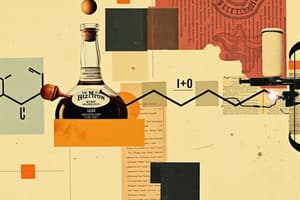Podcast
Questions and Answers
What is used to produce epoxide in epoxide formation?
What is used to produce epoxide in epoxide formation?
RCO3H
Epoxide formation uses ______ to produce epoxide, then H3O+ to produce anti addition of 2 OH (diol)
Epoxide formation uses ______ to produce epoxide, then H3O+ to produce anti addition of 2 OH (diol)
RCO3H
Epoxide formation uses RCO3H to produce epoxide, then _____ to produce anti addition of 2 OH (diol)
Epoxide formation uses RCO3H to produce epoxide, then _____ to produce anti addition of 2 OH (diol)
H3O+
Epoxide formation uses RCO3H to produce epoxide, then H3O+ to produce anti addition of 2 ____ (diol)
Epoxide formation uses RCO3H to produce epoxide, then H3O+ to produce anti addition of 2 ____ (diol)
Epoxide formation uses RCO3H to produce epoxide, then H3O+ to produce anti addition of 2 OH (_____)
Epoxide formation uses RCO3H to produce epoxide, then H3O+ to produce anti addition of 2 OH (_____)
Epoxide formation is anti addition, meaning 2 OH will be on the same side.
Epoxide formation is anti addition, meaning 2 OH will be on the same side.
Epoxide has an oxygen bonded to both carbons, and the carbons have 1 wedge and 1 dash each.
Epoxide has an oxygen bonded to both carbons, and the carbons have 1 wedge and 1 dash each.
H3O+ is added to epoxide to produce syn addition of 2 OH (diol).
H3O+ is added to epoxide to produce syn addition of 2 OH (diol).
What compounds are involved in epoxide formation?
What compounds are involved in epoxide formation?
Flashcards are hidden until you start studying
Study Notes
Epoxide Formation Overview
- Epoxide formation involves converting precursor compounds using RCO3H to yield an epoxide.
- Subsequent treatment with H3O+ results in the anti-addition of two hydroxyl (OH) groups, leading to the formation of a diol.
Key Reagents
- RCO3H: A reagent essential for creating epoxides.
- H3O+: Plays a crucial role in converting epoxides into diols via anti-addition of hydroxyl groups.
Mechanism Details
- The process produces the diol via an anti-addition mechanism, which results in hydroxyl groups being added on opposite sides of the original epoxide.
Structural Characteristics
- An epoxide features an oxygen atom bonded to two carbon atoms, where each carbon exhibits one wedge and one dash bond, indicating its stereochemistry.
Final Products
- The end product of the reaction is a diol, characterized by having two hydroxyl (OH) groups, resulting from the anti-addition process.
Summary of Process
- The complete reaction pathway involves initial formation of an epoxide using RCO3H, followed by hydration using H3O+ leading to the production of an anti-addition diol.
Studying That Suits You
Use AI to generate personalized quizzes and flashcards to suit your learning preferences.




